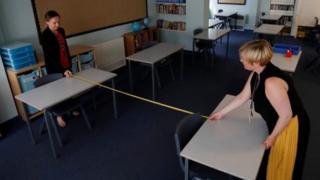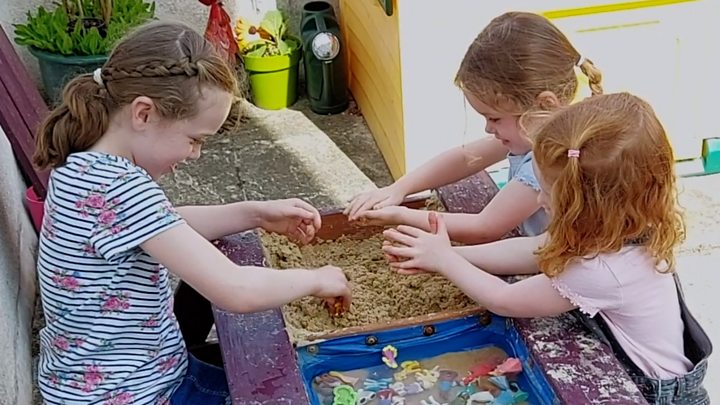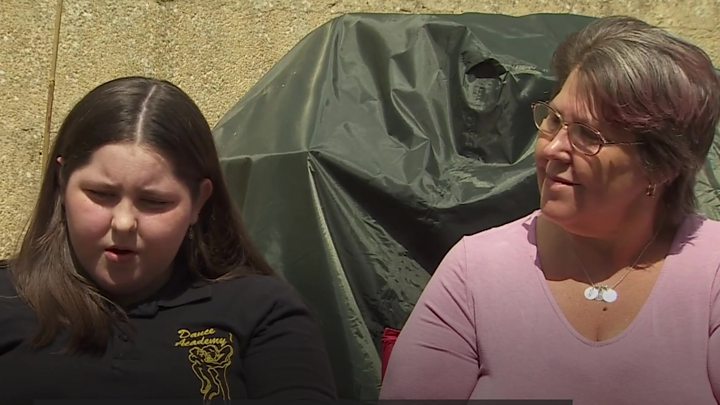 Image copyright
Reuters
Image copyright
Reuters
Wales is moving towards re-opening schools for the first time since the lockdown restrictions came into force in March.
Education is devolved so the decision rests with the Welsh education minister.
All pupils will be able to return for limited periods during the week from 29 June - but only a third of pupils would be allowed into school at any time.
Here are a few of the main questions answered, from what we know so far:
What is the Welsh Government's thinking about children going back to school?
The Welsh Government had made clear they had an "ambition" for some pupils to return before the summer break in mid-July and this gives a taste of school for all pupils before September.
The message is now: "Check in, catch up, prepare for summer and September."
They have stressed they would be guided by five principles including the safety and wellbeing of pupils and staff and whether it contributes to the wider strategy to combat Covid-19, and they've said there'll be at least three weeks' notice of any changes.
"We will use the last weeks of the summer term to make sure pupils, staff and parents are prepared - mentally, emotionally and practically - for the new normal in September," said Education Minister Kirsty Williams.
But she was also conscious about the loss of schooling already and said waiting until September would be "detrimental to the wellbeing, learning progress and mental health of our young people".
Is there much difference to what is happening in England?
Some pupils returned to primary school in England from 1 June but that didn't happen in Wales. The plans for English schools have proved controversial - and there was a "highly variable" level of attendance, while some local authorities said they wouldn't be ready to open.
Nursery, reception, year 1 and year 6 children will go back first in England - but the Welsh Government is looking to give all pupils a taste before the summer.
What is the actual risk to children?
The risk of coronavirus to pupils in the classroom is "very, very small, but not zero", according to UK government's scientific advisory group Sage.
Risk expert Prof Sir David Spiegelhalter ,of Cambridge University, told the BBC in May: "Based on the data so far there have been extremely low risks to children. Out of seven million five to 14-year-olds in England and Wales, so far there has been one death with Covid marked on the death certificate.
"Now there will be more but it's still an unbelievably low risk. And we must remember this group of kids are staggeringly safe in general - less than one in 10,000 die every year. I don't think any [group] has been safer in the history of humanity."

The scientific advisory group Sage has said the role of children in the transmission of Covid-19 was uncertain, while Prof Spiegelhalter also urged caution about claims that children could spread infection, as some of the evidence presented so far had been weak.
A study by the University of Edinburgh and the Usher Institute said there was a risk of transmission by infected children, although there was no evidence of children being a main source of infection.
How might classrooms look?
With fewer pupils going into school at any one time, it will make it easier to re-arrange classrooms with fewer desks. The idea is that although classes will be smaller - and children confined to their group - that allows for more intensive teaching, followed by more online learning at home.
The promise is "much smaller classes, providing secure dedicated time with teachers and classmates", says the Welsh Government.
"This time will include online and personalised classroom experience, getting children and teachers ready for a similar experience in September."
How will schools manage if there are smaller class sizes?
Staffing is a concern for headteachers if they have to split classes into smaller groups. They are worried that some staff may not be available because they are shielding or may have children they have to care for and who may not be among the groups returning to school. Classroom space is another issue.
This may not be a problem with groups of children in school at different times, but the education minister has indicated they are looking at options to increase the space available to schools by using other buildings such as village halls or leisure centres.

What other safeguards might need to be in place?
There have been issues raised about how children travel to school - on buses for example. Also, what if the school corridors are narrow? There may need to be a "traffic" system.
And if we look around at practice already elsewhere, we might expect no more than 15 children in a classroom.
Pupils will be asked to wash hands more often than normal and not to share books and toys as much - and not take them home.
Expect staggered break and lunch times, and even timetables and times to arrive and leave.
Parents might be asked not to gather at the school gates when they collect their children and to only enter school buildings by appointment.
Expect more details to follow in the coming days. The Welsh Government will publish guidance, which will include information for schools and councils on managing their facilities and issues around buildings, resources, cleaning and transport.
Can social distancing really work with children in a school?
In Denmark, pupils are split into small groups of about a dozen and are "cocooned" in these in class, at break times and at lunch.
One Cardiff head teacher has said he does not want his school to "look like a huge wasp," with masses of yellow and black warning posters and floor markings and "staff barking orders whenever a child strays off the permitted route to class".
"They will have been traumatised enough by this," says the head of Eastern High School, Armando di Finizio. "I'd rather we took our time to embed good habits in a calm supportive way."
Teachers have been working in schools with pupils of key workers already, what have been the changes?
Some schools have been open for key workers' children and vulnerable children throughout.
School staff have been providing childcare though not formal education for children, usually working on a rota basis.
There has been an increase in the number of children attending since the Easter holidays, but it is still only about 1.2% of the school population.
How long might all this go on for - or are we looking at permanent changes in how things are done?
It's clear the government expects schools to have to work in a different way for a long time and remote learning is likely to remain alongside more face-to-face teaching.
Some see an opportunity in the crisis to rethink the way schools work, including looking at how the school day and term times are organised.
Before the pandemic hit, a group of experts were working on "reimagining" schools in Wales, including options for staggering school holidays for pupils and staff.
What if I'm a parent and I don't want to send my children back just yet?
Families will not be fined if they do not send their children to school this term.
There is an obvious sensitivity to parents and their own instincts and feelings about risks around the virus.
Children and teachers who are shielding or at more risk, including pregnant staff, are not expected to return this term.
This also applies for pupils and teachers who live with relatives who are shielding.
Will all schools have to open on 29 June?
This is not seen as an issue, with councils saying all schools will be ready to open.
However ministers will be assessing the situation in the coming three weeks.
What about the schooling missed since March?
There is a concern that more disadvantaged pupils in particular will be at risk from lost schooling.
One report, commissioned by the UK government, is worried that the attainment gap between richer and poorer students, which had been closing, will grow.
"Making up for lost time is almost certain to be the biggest challenge facing Wales' education system in the coming months and years," says Gareth Evans, director of education policy at the University of Wales Trinity Saint.
"Some children will have gone eight weeks and counting with no access to online learning, and there is little doubt that those from more deprived backgrounds will have fallen further behind their more affluent peers.
"Talk of a 'lost generation' is entirely legitimate and the widening of the attainment gap should be a worry for us all."
He believes there needs to be a "thorough evaluation" of how pupils have progressed or otherwise since lockdown and learning programmes tailored to individual need, not to mention sensitive assessment of health and well-being.
What happens to key worker child care provisions?
Children of key workers will continue to get the same care as they do now, however, they will be returning to their own schools, rather than staying at the hubs.